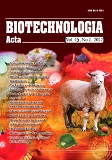ISSN 2410-7751 (Друкована версія)
ISSN2410-776X (Електронна версія)

Biotechnologia Acta Т. 15, No. 2, 2022
P. 64-65, Bibliography 4, Engl.
UDC: 577.112
https://doi.org/10.15407/biotech15.02.064
Y. Raynich2, T. D. Skaterna1, D. S. Gerashenko1, O.V. Khudiakova1, L. V. Garmanchuk1, L. B. Drobot1
1 Palladin Institute of Biochemistry of the National Academy of Sciences of Ukraine, Kyiv
2 Taras Shevchenko National University, Kyiv, Ukraine
The aim of this study was to elucidate the regulatory role of Ruk/CIN85 in chemoresistance and EMT using human NSCLC MOR cells as a model.
Methods. MOR (ECACC 84112312) cell line and drug-resistant cell line MOR/0.2R (ECACC 96042335) were cultured under standard conditions in DMEM medium. Knockdown of Ruk/CIN85 in MOR/0.2R cells was performed using shRNA lentiviral technology. Expression levels of Ruk/CIN85, vimentin and E-cadherin were estimated by RT-PCR.
Results and Discussion. According to the results of qPCR, MOR/0.R cells showed an extremely higher level of Ruk/CIN85 mRNA expression, more than 10 times higher than the parental MOR cells. Preliminary data revealed that knockdown of Ruk/CIN85 in the MOR/0.2R cells led to significant decrease of their resistance to doxorubicin and development of epithelial phenotype. High content of RukCIN85 in doxorubicin-resistant (MOR/R) cells strongly correlate with their mesenchymal phenotype (high expression level of vimentin and low – E-cadherin), while its down-regulation is followed by restoration of expression values characteristic of parental MOR cells.
Conclusions. In summary, high expression level of Ruk/CIN85 in doxorubicin-resistant MOR cells and the reversion of EMT-related transcriptome parameters and sensitivity to drug due to knockdown of adaptor protein in this subline suggests its involvement in regulation of EMT as well as cancer cells chemoresistance. Thus, the adaptor protein Ruk/CIN85 can be considered as a tissue-specific marker of carcinogenesis and perspective target for drug development.
Key words: NSCLC, adaptor proteins, Ruk/CIN85, chemoresistance, epithelial-mesenchymal transition
© Palladin Institute of Biochemistry of the National Academy of Sciences of Ukraine, 2022
References
1. Havrylov S., Redowicz M. J., Buchman V. L. Emerging roles of Ruk/CIN85 in vesicle-mediated transport, adhesion, migration and malignancy. Traffic. 2010, 11(6), 721-7?31. https://doi.org/10.1111/j.1600-0854.2010.01061.x
2. Twentyman PR, Fox NE, Wright KA, Bleehen NM. Derivation and preliminary characterisation of adriamycin resistant lines of human lung cancer cells. Br. J. Cancer. 1986; 53(4):529?37. https://doi.org/10.1038/bjc.1986.83
3. Horak IR, Geraschenko DS, Drobot LB. Adaptor protein Ruk/CIN85 modulates resistance to doxorubicin of murine 4T1 breast cancer cells. Ukr. Biochem. J. 2018; 90(3): 94?100. https://doi.org/10.15407/ubj90.03.094
4. Lamouille S, Xu J, Derynck R. Molecular mechanisms of epithelial–mesenchymal transition. Nat Rev Mol Cell Biol. 2014; 15(3): 178–196. https://doi.org/10.1038/nrm3758

